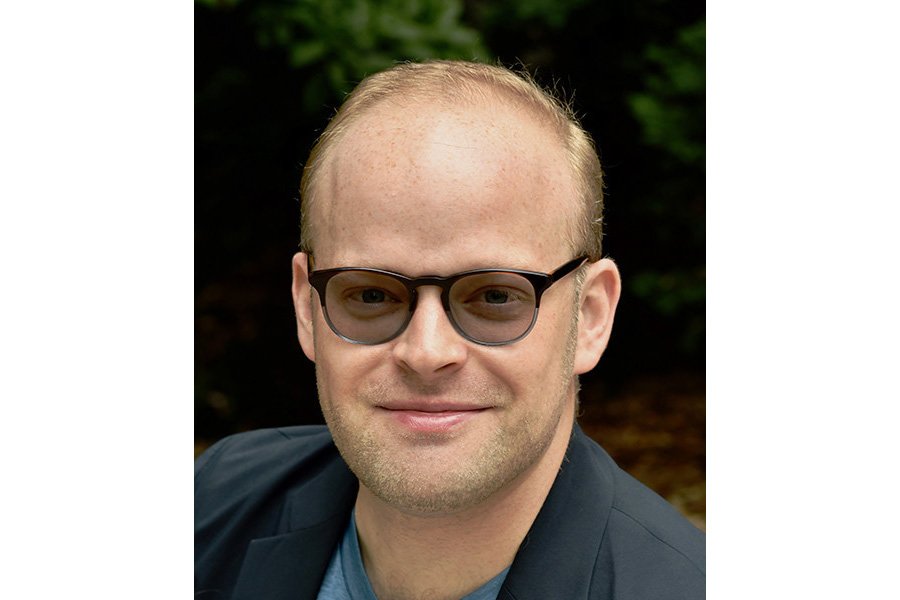Focus on Nano Microscopy: New Faculty member develops tools to unlock novel physics

Alex McLeod is a new faculty member in Condensed Matter Experimental Physics at the School. His area of focus is materials, which he studies with nano-scale microscopes.
In trying to understand how nano-materials interact with light, McLeod has developed new tools. “Some of the new microscopy techniques my program is using are akin to developing eyes with nanometer-level resolution, which will allow us to see directly how light is interacting with nanomaterials.”
The key to this microscopy isn’t some spectacular new invention. It’s one that’s been around for most of human history: a needle. In McLeod’s research a needle with a very sharp apex guides a handful of photons from a laser to probe materials.
Using a vacuum chamber about the size of a typical office desk, Mcleod achieves levels of cleanliness that rival outer space. Inside the vacuum are precision manipulators, mirrors, and laser beams pointed at the heart of the probe. Intense photon pulses are guided to the 10 nanometer gap between the needle point and the surface. McLeod says that future versions of the set-up will shrink that 10 nm gap even further.
He says that developing that toolset is incredibly satisfying. “We can literally see things that physicists have dreamed of seeing for the past 100 years, a pursuit even Einstein thought improbable.” The reason scientists have not been able to use light to do nanoscale microscopy is the so-called diffraction limit. Isaac Newton showed that light could be split with a prism in the phenomenon known as diffraction. All conventional microscopes are limited by diffraction, which limits the size of a spot into which a given number of photons (particles of light) can be squeezed, but McLeod and his colleagues have found a way to sneak in under that limit. By using a nanoscale probe to focus light to a an even smaller volume, they can circumvent the barriers of conventional physics. “The cap has been blown off the diffraction limit,” McLeod says. “It simply requires this next generation of scanning probe technologies to make use of that.”
McLeod’s lab will become a unique environment where new materials will show their true colors: taking them to ultra low temperatures, exposing them to high magnetic fields, ultra high vacuum, light pulses, or electrical signal, McLeod and his group will use nano-eyes in real time to investigate how the materials react. “What makes a material a quantum material, is one in which quantum mechanics gives you a gift.” These materials are extremely sensitive to external stimuli. By tuning a system to a crossing point of multiple possible ground states, McLeod can control where he wants it to go. For example, with nanoscale microscopy he can see how the superconducting transition manifests, which is very relevant for technologies that are going to use these materials.
Quantum electrodynamics is a whole field that studies the interaction between light and matter. In classical electrodynamics, matter and light interact as independent systems, but in an environment enriched by photons, the boundary of light and matter gets blurred. One can thus change the allowed states of matter. For instance, introducing a nanoscale cavity can modify the electronic states, and this can re-engineer how the electrons are behaving. The volume is so small that the quantum scale of this effect is enhanced. The goal of these manipulations is to coax the material into showing new properties on demand. The variety of phase transitions available using this technology will allow McLeod to actually do experiments in quantum electrodynamics using novel phases of condensed matter.
McLeod says that physicists are only just beginning to exploit the potential of this scanning technique. “We have access to the whole range of colors, the whole range of energies of photons. The resonances of electrons detected by the probe allows studying how quantum materials behave. But the resonances of chemical vibrations also enable chemical fingerprinting at the nanoscale. The potential usefulness in other fields like catalysis, biology, and geophysics is only just beginning to be understood, though he has begun to work with astronomers and space physicists to measure samples from meteorites, stardust, and other precious samples recently returned by spacecraft from planetary bodies. They are far too small and delicate to address with most microscopes, but probing the nano-scale chemistry preserved in these materials may shed light (quite literally) on the ingredients for life once delivered to Earth. Prof. McLeod quotes Yankees guru Yogi Berra, “Indeed ‘you can observe a lot just by watching’, and now in our lab we finally have the eyes for that!”